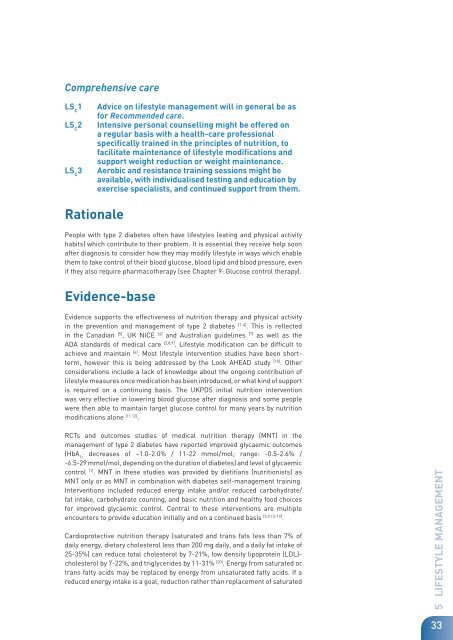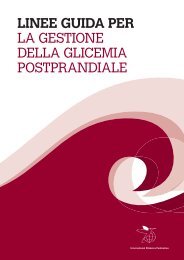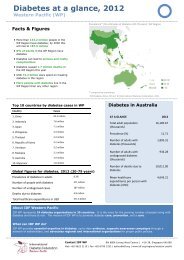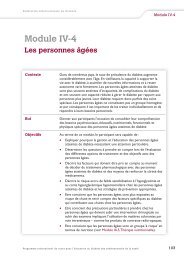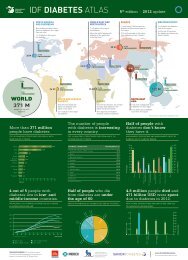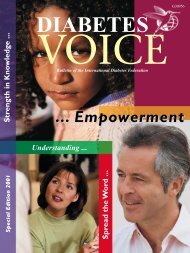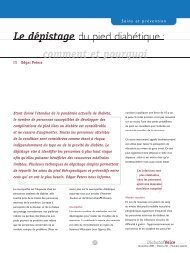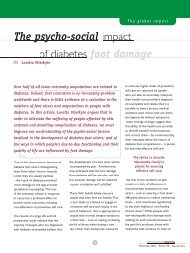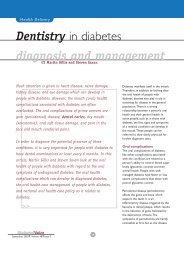Evidence-base - International Diabetes Federation
Evidence-base - International Diabetes Federation
Evidence-base - International Diabetes Federation
You also want an ePaper? Increase the reach of your titles
YUMPU automatically turns print PDFs into web optimized ePapers that Google loves.
Comprehensive care<br />
LS C 1 Advice on lifestyle management will in general be as<br />
for Recommended care.<br />
LS C 2 Intensive personal counselling might be offered on<br />
a regular basis with a health-care professional<br />
specifically trained in the principles of nutrition, to<br />
facilitate maintenance of lifestyle modifications and<br />
support weight reduction or weight maintenance.<br />
LS C 3 Aerobic and resistance training sessions might be<br />
available, with individualised testing and education by<br />
exercise specialists, and continued support from them.<br />
Rationale<br />
People with type 2 diabetes often have lifestyles (eating and physical activity<br />
habits) which contribute to their problem. It is essential they receive help soon<br />
after diagnosis to consider how they may modify lifestyle in ways which enable<br />
them to take control of their blood glucose, blood lipid and blood pressure, even<br />
if they also require pharmacotherapy (see Chapter 9: Glucose control therapy).<br />
<strong>Evidence</strong>-<strong>base</strong><br />
<strong>Evidence</strong> supports the effectiveness of nutrition therapy and physical activity<br />
in the prevention and management of type 2 diabetes [1-4] . This is reflected<br />
in the Canadian [5] , UK NICE [6] and Australian guidelines [7] as well as the<br />
ADA standards of medical care [2,8,9] . Lifestyle modification can be difficult to<br />
achieve and maintain [6] . Most lifestyle intervention studies have been shortterm,<br />
however this is being addressed by the Look AHEAD study [10] . Other<br />
considerations include a lack of knowledge about the ongoing contribution of<br />
lifestyle measures once medication has been introduced, or what kind of support<br />
is required on a continuing basis. The UKPDS initial nutrition intervention<br />
was very effective in lowering blood glucose after diagnosis and some people<br />
were then able to maintain target glucose control for many years by nutrition<br />
modifications alone [11,12] .<br />
RCTs and outcomes studies of medical nutrition therapy (MNT) in the<br />
management of type 2 diabetes have reported improved glycaemic outcomes<br />
(HbA 1c decreases of ~1.0-2.0% / 11-22 mmol/mol; range: -0.5-2.6% /<br />
-6.5-29 mmol/mol, depending on the duration of diabetes) and level of glycaemic<br />
control [1] . MNT in these studies was provided by dietitians (nutritionists) as<br />
MNT only or as MNT in combination with diabetes self-management training.<br />
Interventions included reduced energy intake and/or reduced carbohydrate/<br />
fat intake, carbohydrate counting, and basic nutrition and healthy food choices<br />
for improved glycaemic control. Central to these interventions are multiple<br />
encounters to provide education initially and on a continued basis [5,9,13-19] .<br />
Cardioprotective nutrition therapy (saturated and trans fats less than 7% of<br />
daily energy, dietary cholesterol less than 200 mg daily, and a daily fat intake of<br />
25-35%) can reduce total cholesterol by 7-21%, low density lipoprotein (LDL)cholesterol<br />
by 7-22%, and triglycerides by 11-31% [20] . Energy from saturated or<br />
trans fatty acids may be replaced by energy from unsaturated fatty acids. If a<br />
reduced energy intake is a goal, reduction rather than replacement of saturated<br />
5 LIFESTYLE MANAGEMENT<br />
33


